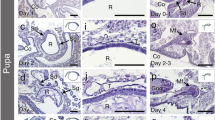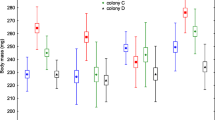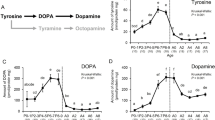Abstract
Stinging behavior has been extensively studied in honey bees at the level of the individual, that is, in terms of stimuli that release stinging in adult bees, and in terms of integration of individual behavior into colony defense. Yet very little is known about the physiological basis for this behavior. Using an isolated abdominal preparation factors that influence peripheral control of the sting extension response are analyzed. Results show that:
-
1.
Electromyogram activity released by severing the ventral nerve cord changed during the first few days of adult life but not later. Abdomens from older bees (nurses, guards, foragers) showed significantly higher EMG activity than newly emerged or 24 h-old bees.
-
2.
The reflex “matured” over 5–7 days after emergence as an adult.
-
3.
Younger bees (≤24h) had a lower threshold for initiating sting extension than older bees. However, the threshold for initiating the full sting response, i.e., extension and venom pumping, did not differ due to age.
-
4.
Caste status was not correlated to any of the parameters of sting extension, indicating that any effect of caste on stinging behavior must arise in more anterior ganglia and/or in the brain.
Similar content being viewed by others
References
Allan SA, Slessor KN, Winston ML, King GGS (1987). The influence of age and task specialization on the production and perception of honey bee pheromones. J Insect Physiol 33:917–922
Beltz BS, Kravitz EA (1986) Aminergic and peptidergic neuromodulation in Crustacea. J Exp Biol 124:115–141
Harris JW, Woodring (1992) Effects of stress, age, season, and source colony on levels of octopamine, dopamine, and serotonin in the honey bee (Apis mellifera L.) brain. J Insect Physiol 38:29–35
Kravitz EA (1990) Hormonal control of behavior: amines as gainsetting elements that bias behavioral output in lobsters. Am Zool 30:595–608
Kolmes SA, Ferguson-Kolmes LA (1989). Stinging behavior and residual value of worker honey bees (Apis mellifera). J New York Entomol Soc 97:218–231
Lindauer M (1952) Ein Beitrag zur Frage der Arbeitsteilung im Bienenstaat. Z Vergl Physiol 34:299–345
Livingstone MS, Harris-Warwick RM, Kravitz EA (1980) Serotonin and octopamine produce opposite postures in lobsters. Science 208:76–79
Marder E, Hooper SL (1985) Neurotransmitter modulation of the stomatogastric ganglion of decapod crustaceans. In: Selverston AI (ed) Model neural networks and behavior. Plenum Press, New York, pp 319–337
Masson C, Arnold G (1987) Organization and plasticity of the olfactory system of the honeybee, Apis mellifera. In: Menzel R, Mercer A (eds) Neurobiology and behavior of honeybees. Springer, Berlin, pp 280–295
Moore AJ, Breed MD, Moore MJ (1987) The guard bee: ontogeny and behavioral variability of workers performing a specialized task. Anim Behav 35:1159–1167
O'Gara BA, Chae H, Latham LB, Friesen WO (1991) Modification of leech behavior patterns by reserpine-induced amine depletion. J Neurosci 11:96–110
Pearson KG (1985) Are there central pattern generators for walking and flight in insects? In: Barnes WJP, Gladden MH (eds) Feedback and motor control in invertebrates and vertebrates. Croom Held, London, pp 307–315
Pence RJ, Lomax P (1973) Biodynamics of excised honey bee abdomen. Insect World Digest 1:16–24
Robertson RM, Pearson KG. (1985) Neural networks control locomotion in locusts. In: Selverston AI (ed) Model neural networks and behavior. Plenum Press, New York, pp 21–35
Robinson GE (1985) Effects of a juvenile hormone analog on the honey foraging behavior and alarm pheromone production. J Insect Physiol 31:277–282
Robinson GE (1987) Hormonal regulation of age polyethism in the honeybee, Apis mellifera. In: Menzel R, Mercer A (eds) Neurobiology and behavior of honeybees. Springer, Berlin, pp 266–279
Robinson GE (1992) Regulation of division of labor in insect societies. Annu Rev Entomol 37:637–665
Robinson GE, Page RE, Strambi C, Strambi A (1989) Hormonal and genetic control of behavioral integration in honey bee colonies. Science 246:109–112
Rowell CHF (1964) Central control of an insect segmental reflex. I. Inhibition by different parts of the central nervous system. J Exp Biol 41:559–572
Rowell CHF (1969) Central control of an insect segmental reflex. II. Analysis of the inhibitory input from the metathoracic ganglion. J Exp Biol 50:191–201
Sakagami SF, Akahira Y (1960) Studies on the Japanese honeybee, Apis cerana cerana Fabricus. VIII. Two opposing adaptions in the post-stinging behavior. Evolution 14:29–40
Sakagami SF, Fukuda H (1968) Life tables for worker honeybees. Res Population Ecol 10:127–139
Seeley TD (1982) Adaptive significance of the age polyethism schedule in honey bee colonies. Behav Ecol Sociobiol 11:287–293
Snodgrass RE (1956) Anatomy of the honey bee. Cornell University Press Ltd, London
Sokal RR, Rohlf FJ (1981) Biometry. WH Freeman and Co, New York
Stabentheiner A, Hagmüller K (1991). Sweet food means “hot dancing” in honeybees. Naturwissenschaften 78:471–473
Taylor DJ, Robinson GE, Logan BJ, Laverty R, Mercer AR (1992) Changes in brain amine levels associated with morphological and behavioral development of the worker honeybee. J Comp Physiol A 170:715–721
Thompson KJ (1986a) Oviposition digging behavior in the grasshopper. I. Functional anatomy and the motor programme. J Exp Biol 122:387–411
Thompson KJ (1986b) Oviposition digging behavior in the grasshopper. II. Descending neural control. J Exp Biol 122:413–423
Whim MD, Evans PD (1988) Octopaminergic modulation of flight muscle in the locust. J Exp Biol 134:247–266
Whim MD, Evans PD (1989) Age-dependence of octopaminergic modulation of flight muscles in the locust. J Comp Physiol A 165:125–137
Willard AL (1981) Effects of serotonin on the generation of the motor program for swimming by the medicinal leech. J Neurosci 1:936–944
Author information
Authors and Affiliations
Rights and permissions
About this article
Cite this article
Burrell, B.D., Smith, B.H. Age- but not caste-related regulation of abdominal mechanisms underlying the sting reflex of the honey bee, Apis mellifera . J Comp Physiol A 174, 581–592 (1994). https://doi.org/10.1007/BF00217379
Accepted:
Issue Date:
DOI: https://doi.org/10.1007/BF00217379




